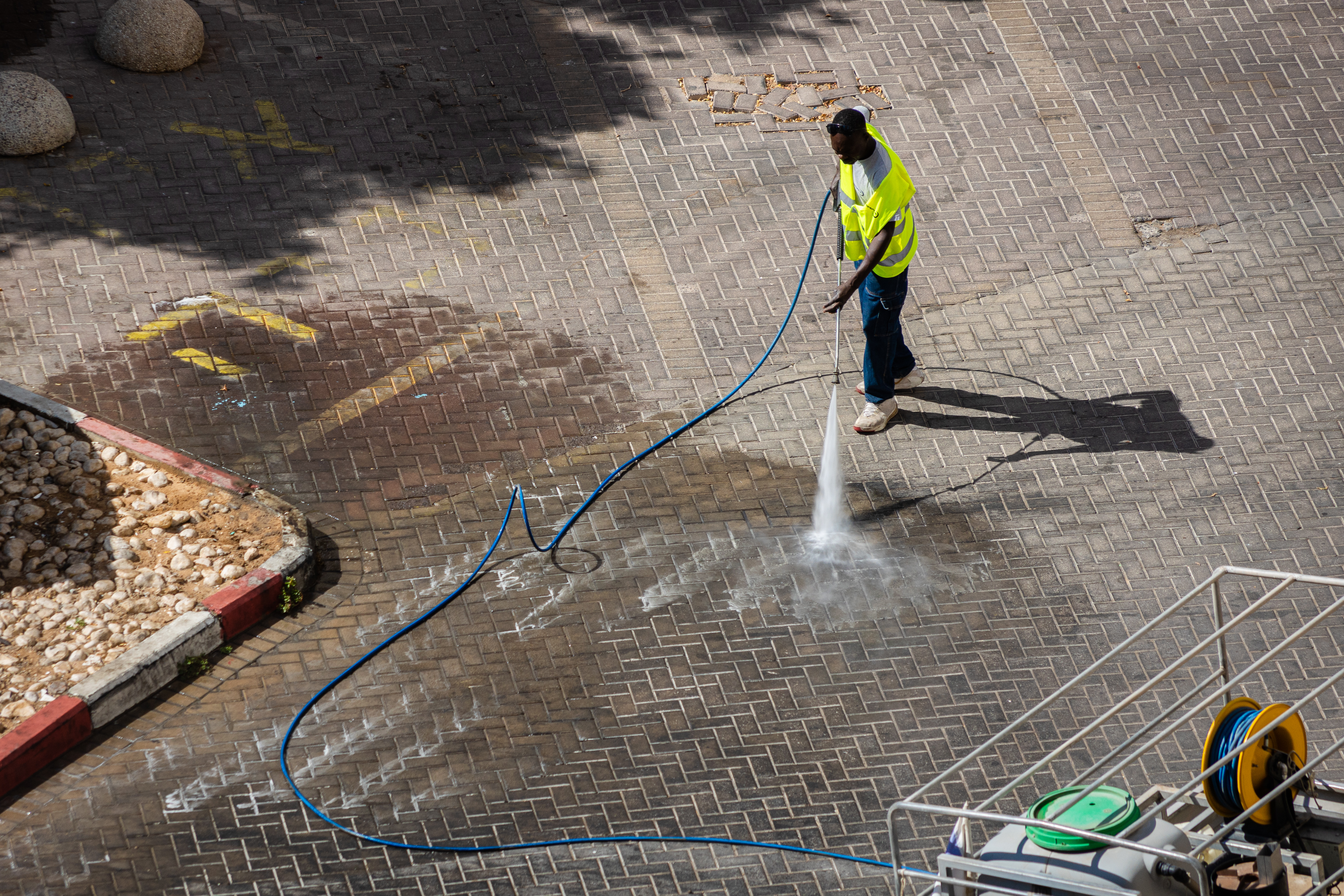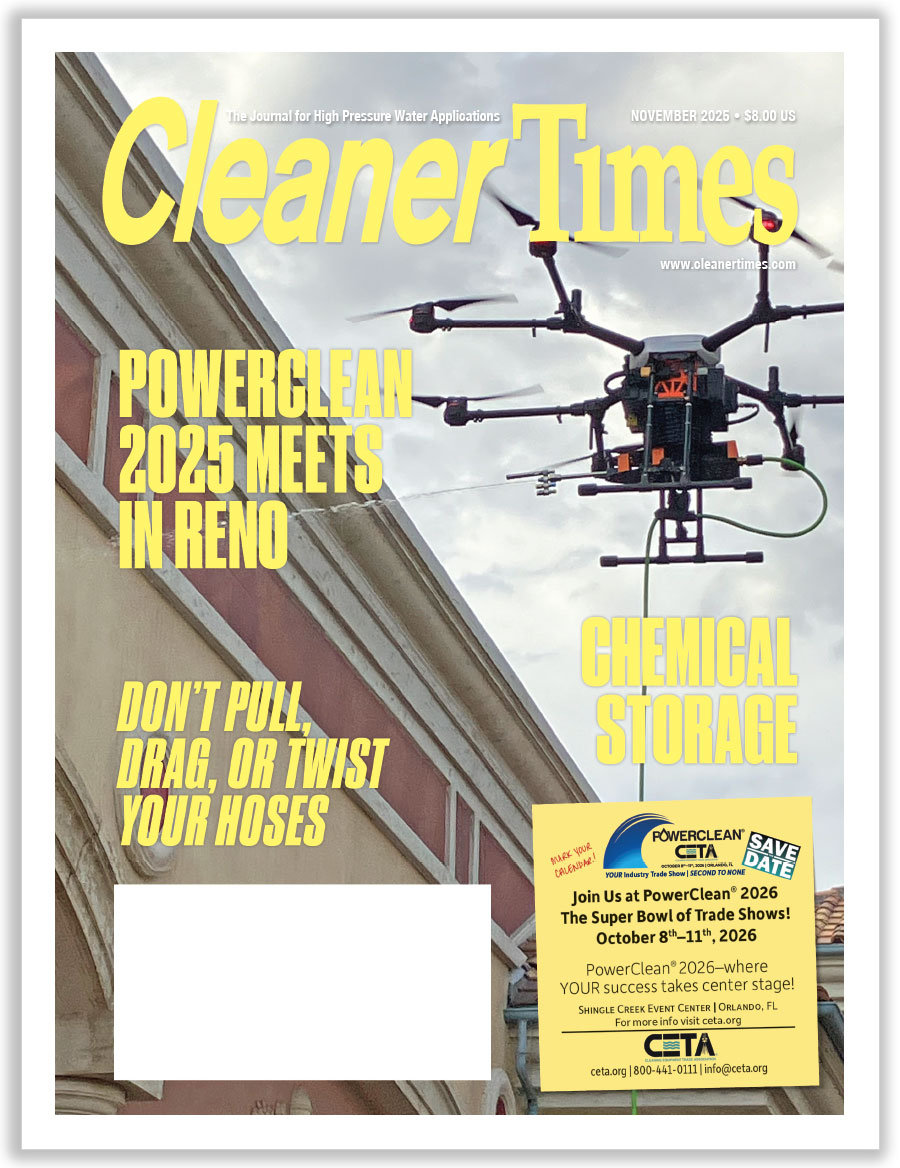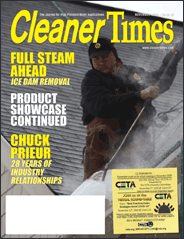
Hoses: Don’t Pull, Drag, or Twist Them
by Diane M. Calabrese | Published November 2025

A tube for getting liquid from one place to another, if it is flexible and long, meets the general definition of a hose. The cutoff point between hose and pipe can be murky; just how flexible must a tube be to become a hose? The word hose probably derives from the Dutch word for water pipe.
In some English-language settings hoses are still called hosepipes. The legacy of the Dutch root word for a flexible liquid-conveying tube—the hose of our story—also includes stockings, socks, and hosiery.
Firm pipes alone, such as the lances of our industry, cannot get the myriad jobs of conveying liquids done. Hoses figure prominently.
Inside and outside our industry, everyone knows the first thing about hoses. Don’t drive over them.
Yet there’s much more we should know. Fortunately, three individuals well acquainted with hoses help us learn more or at least recall some of what we should know but may have forgotten.
“For users of pressure washers, hoses are generally overlooked,” says Jeff Theis, president and CEO of ProPulse, a Schieffer Company based in Peosta, IA. “They get what the original manufacturer uses, much like the way car makers supply tires.”
Variables of use might mean there’s a better choice, though. “For some users the factory hose is perfectly acceptable; but for others, finding a balance between various features is more important, especially for cleaning contractors or production operations where hoses are used for extended periods every day,” explains Theis.
Theis’s company is the leading pressure washer hose manufacturer in North America and has been for decades. It holds numerous hose-related U.S. utility patents. (And its contributions to industry extend well beyond water-carry hoses to hydraulics, for example.)
Extended periods of use each day are to pressure washer operators what high-mileage driving days are to vehicle operators. “So, in those cases, longevity and ergonomics should be considered,” says Theis.
More use means also more exposure to the environment. That must be considered.
Take UV (ultraviolet) light as an example. “If a hose is to be used and/or stored outdoors, this is important,” says Theis.
“Have you ever noticed that tires on recreational vehicles are often covered when parked?” says Theis. “That is because long-term exposure to ultraviolet light and ozone present in the environment will leach the aromatic oils, and the rubber will start to break down, sometimes called ‘weather checking.’”
Perils of prolonged UV exposure can be exacerbated. That condition “combined with heat, hot water applications, and a wide range of chemicals can accelerate [weather checking] and result in delamination or damage to the hose cover and inside tube,” explains Theis.
Less expensive hoses usually signal they were made with less expensive materials and less stringent verifications of integrity. That means they may succumb faster.
“Cheap hoses are especially susceptible to such rapid aging,” says Theis. “Often colored hoses—so-called non-marking—are not properly compounded using the expensive UV and ultraviolet inhibitors that prevent fading and discoloration. A gray hose should not turn brown after a couple of weeks of use.”
Longevity, of course, is a persistent concern for equipment users, but it’s just one of many. Ease of use is another.
For instance, gaining a longer lifespan for a hose by adding to its weight is a less-than-desirable choice. Balance is the operative goal.
Thus, “light weight” is certainly one of the features end users look for in hoses, says Theis. “It is a longstanding conclusion that ‘hose management’ or ‘hose handling’ is a common complaint of users.”
The heavier and stiffer the hose is, the more difficult unrolling, moving, and recoiling the hose will be, explains Theis. “Dragging hoses over hard or sharp surfaces—think parking lots and/or concrete stairs—will accelerate cover wear.”
Surface damage accelerates deterioration. “That abrasion will eventually expose the reinforcement material leading to hose failure,” explains Theis.
And here’s where the balancing act comes in. In fact, it’s one that every ardent gardener who operates with both lightweight and heavier hoses can confirm.
“It stands to reason that a lighter hose will not abrade as quickly just due to less surface friction,” says Theis. “On the other hand, most contractors using hot-water machines lean toward using two-wire reinforced hoses versus one-wire reinforced hoses even with the heavier weight. This is largely attributed to longer life of two-wire hoses due to an inherent design life that provides for longer impulse resistance.”
The type of material(s) from which a hose is made obviously affects its service and longevity. It’s another consideration for anyone using a hose.
Contrast rubber and thermoplastic. “Our company manufactures high-tenacity yarn and steel wire thermoplastic hoses, and one- and two-wire reinforced rubber hoses,” says Theis.
“Thermoplastic hoses in general have better abrasion resistance than rubber hoses,” explains Theis. “Part of the reason is they are inherently lighter. Also, chemical and UV resistance is vastly better.”
So why not just use all thermoplastic? “Thermoplastic hoses are generally limited to operating at a maximum temperature of about 160°F. Rubber hoses are preferred for higher temperatures as rubber is a thermoset material and very stable.”
But context is everything, and the major division for the pressure washer user begins with hot water or cold water. “The vast majority of pressure washer population in the field are cold water machines,” says Theis. “Therefore, thermoplastic hoses are the preferred option often due to price considerations.”
The main issue for the end user, however, is that most of the thermoplastic hoses are stiff, use inexpensive materials, and kink easily and permanently, explains Theis.
“There are more expensive options that are kink resistant and more flexible, which are desirable characteristics.”
In the category of kink resistant and more flexible thermoplastic hoses, there are several contenders. Theis cites his company’s U.S. made Uberflex.
Thinking It Through
Getting the longest service and best service from a hose begins with a careful assessment of needs and goals before the purchase is made. Make a list of features wanted and be able to check off each one.
Light, durable, and easily retractable is the condensed list we suggested as a basic one to Jeff Schultz, general manager of Suttner America Company in Dubuque, IA, a manufacturer of precision-engineered components (nozzles, lances, connections, etc.). Is the list we propose reasonable?
“I would add that pressure rating, flexibility, non-marking, abrasion resistant, and heat resistant are also important criteria that can be added to this list,” says Schulz. Naturally, each end user will make his or her own list, working backwards from the way the hose will be deployed.
“Will the length of hose be sufficient for the cleaning application?” says Schultz. That’s a fundamental question about function that ought not be overlooked in the quest to get the best form of hose.
Schultz lists some other questions a hose buyer should be able to answer: “Does the application require a non-marking hose? Is the hose going to be used with a hot- or cold-water unit? Will there be cleaning agents traveling through the hose? If so, make sure the hose is compatible with the cleaning agents being used. What fittings will the hose require for the cleaning application?”
The fittings component is important. Hoses must be coupled (hose plus coupler equals hose assembly). Fittings should never be overlooked.
When creating an assembly, always use the type of coupling or adjustable clamp recommended by the OEM. Whenever a change in coupling or clamp is made, test the assembly before using it.
How important is the material used to construct the hose and ultimately the hose assembly to function? “It is very important,” says Schultz.
“For example, the tube material in a pressure washer hose should be one that is optimum for hot water, cold water, and cleaning agents,” explains Schultz. “Great bonding between the tube, reinforcement, and cover are highly important when constructing a pressure washer hose. The ferrule and fitting materials being used are also quite important when constructing a hose.”
It’s worth pausing to remind readers that the failure to think through the way a hose/hose assembly will be used can lead not only to equipment damage but also to injuries. Safety in use and longevity of a hose both depend upon the correct match being made.
Using a hose that has a working pressure less than the pressure washer can result in a blowout and injury. The foregoing is one of the reminders that Schultz has given to us in another context. Another of his reminders is to always give close attention to the temperature rating.
A good hose/hose assembly matched to use will be the safest, assuming it has been cared for properly. Proper care includes never pulling, yanking, etc., and it includes proper storage. Rubber hoses, for example, require attention to the location of storage. No exposure to sunlight or fluorescent light is one rule. No storage near electrical equipment (tie to ozone production) is another.
Uniformity
An equipment user wants to be able to be able to do apples-to-apples comparisons. Apples to oranges comparisons are just not useful.
CETA [Cleaning Equipment Trade Association] is committed to facilitating a move toward uniformity whenever possible. Gus Alexander, the CEO of FNA Group in Pleasant Prairie, WI, tells us about the efforts underway involving hoses.
“The CETA technical committee is working on the final touches regarding our standard for high-pressure hoses,” says Alexander. “We expect that the standard should be approved by the CETA board of directors for publication included in CPC 100 performance standard shortly.”
Guideposts help keep everyone on track. So it is with standards, such as the one being developed.
“The goal is providing a performance standard to be used by our CETA members and CETA associate members,” explains Alexander. “This new standard is the result of extensive industry collaboration, technical expertise, and contractor input to ensure that high-pressure hoses meet the needs of durability, safety, and reliability in the field.”
In addition to the trio of factors Alexander enumerates, there is the overarching objective of moving the industry in the direction of uniformity–uniformity that enables comparison and fosters strength.
Why such a goal? “To make certain that we provide measurable, uniform performance criteria across manufacturers,” explains Alexander, “thereby giving end users confidence and helping distributors, contractors, and end users easily identify compliant, high-quality hoses as we continue to position CPC 100 as the trusted benchmark for professional cleaning equipment, raising standards across our industry.”
Alexander offers a general observation about the way hoses are viewed in our industry. “Normally contractors really don’t pay attention to hose material since they expect the sellers and manufacturers of hoses to take responsibility in providing reliable material.”
Among contractors “the focus is very often on how long it lasts, how easy it is to use, and whether it’s safe for the pressure/temperature/chemical load of the job,” explains Alexander. “Contractors may focus on psi and gpm ratings, but the wrong material can make a hose frustrating, short lived, or even unsafe.”
Alexander’s company is a U.S. manufacturer of high-pressure hoses. On his list of core criteria for high-pressure cleaner hoses are the following: durability and abrasion resistance, ease of handling (flexibility), ease of storage retractability—including reel compatibility, pressure rating, and safety—including the “must” of burst protection, temperature resistance, chemical resistance, connection integrity, length options, cost/ value balance, and warranty and brand trust.
Each of the experts commenting herein could offer many, many more insights into hose structure and function. But we conclude with an interesting observation from Alexander that illustrates the significance of manufacturers learning from end users and distributors.
“Contractors often prefer longer hoses—50 to 200 feet—to reduce moving the pressure washer constantly,” explains Alexander. Reflect on that information.
When a manufacturer provides a contractor with the optimal length hose, the manufacturer promotes safety, enhances positive ergonomic outcomes, and bolsters the possibility that a hose will attain its manufacturer-predicted lifespan. All because the hose is less likely to be pulled, dragged, or twisted.





